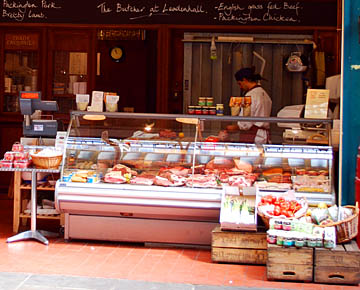It became increasingly common for municipal authorities to provide some kind of covered space for selected market vendors. Although only a minority of English towns are known to have had any such space by the close of the Middle Ages, they were a harbinger of things to come. Perhaps they were more common than surviving records show, for as early as 1380 we encounter a complaint that the covered cross constructed for the sale of wares in the marketplace of Findon, Sussex, had been wantonly torn down. Some spaces created for vendors were in multi-purpose buildings, others were primarily intended for market use.
a. Thaxted
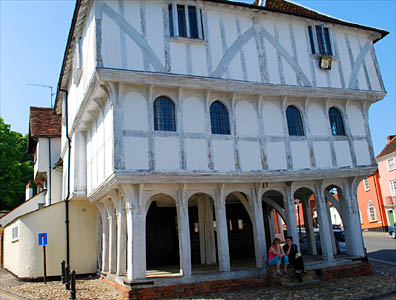
The guildhall at Thaxted
Photo © S. Alsford
A structure that combines features of guildhall and market hall was built in the small market town of Thaxted, Essex, ca. 1450 on a triangular site at a junction of three roads, in one of which the market – owned by the manorial lord and recorded as early as 1296 – was held. This guildhall and other (smaller) houses along the high street, also mostly built in the fourteenth and fifteenth century, point to infilling of a once-larger marketplace. The guildhall is suspected to have been an initiative of cutlers, who were present in such large numbers, and their work the mainstay of the local economy, that it is assumed they would have been organized in a gild; at the least they must have been a prominent community interest group in the unchartered town.
Domesday suggests Thaxted was a relatively prosperous village, and it appears in the Late Middle Ages as a manor with a market town appended, the latter having burgage tenure, but no formal self-government. The guildhall seems to have replaced at least part of a pre-existing building, sitting atop an older cellar and with its back formed from the wall of an adjacent house. Its genesis is uncertain but it evidently served multiple functions, with the enclosed top floor probably for gild meetings, and a ground level arcaded gallery for public uses. The flagstone-paved ground floor may have been used for public gatherings but was principally intended as a covered market, housing temporary stalls on market day; the smaller arches may signify placement of vendors, while one wider archway represents an opening off the main market area.
Conceivably the market hall component may have been built first, and the jettied upper storeys added later. The rows of windows around the first floor suggest additional space might have been provided there for stalls or shops. Or it could have been used for meetings of community leaders and local administrators of seigneurial appointment (who included a mayor, chamberlain, market supervisor, and officials enforcing the assizes of bread and ale), with the windows serving for public announcements to a crowd outside; when Thaxted obtained a charter granting self-government (1556), the guildhall immediately became the town hall. The adjacent fourteenth century house was once known by the revealing nickname 'Bymoot', but we cannot know if that indicates the site had earlier been used for community meetings or whether the reference is to that use after the guildhall was built. Space under the rear staircase to the upper levels was used as a short-term lock-up.
b. Titchfield
A similar structure, the former Titchfield Market Hall, has been saved thanks to its transfer to and restoration by a museum. The open arcade of the hall's lower level accommodated market vendors (with and without stalls), while the more private upper floor served for meetings of the local council and had a balcony from which public announcements could be made; under the stairs was a 'cage' to hold offenders. Such timber-framed halls were becoming more common in market towns by the close of the Middle Ages, but most were in later centuries torn down or replaced by completely indoor market halls.
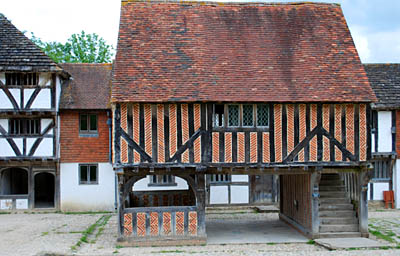
Titchfield Market Hall, in its present setting of
the market square of the Weald and Downland Open Air Museum; at rear left is
a fifteenth century house from Horsham with ground floor shop.
Photo © S. Alsford
Titchfield, situated on the River Meon near its coastal estuary, had a market by 1086 – one of just three mentioned in Domesday's coverage of Hampshire, for it was on a royal estate. Later some trade came through its port (the quayside being near the town bridge), and brewers, butchers, bakers, salters (salt-working was taking place in Titchfield Haven), coopers, carpenters, tanners and other leather-workers are recorded as active there. But it may have been held back from attaining borough status after the king granted the manor to the Bishop of Winchester (1222), who founded an abbey there. The bishop complained, ca.1273, that Titchfield's market was harmful to that on his nearby estate at Bishop's Waltham, but how this conflict was resolved is unclear.
Described as a market town in 1335, Titchfield remained under episcopal control; that some bishop may have embarked on a planned expansion, or redevelopment, of Titchfield is suggested by a rectilinear pattern to certain of its streets and a high degree of regularity in plot sizes there, but there is no evidence of burgage tenure. In 1447 the bishop acquired licence for a four-day fair, to be held in the town, and ca. 1520, built the market hall in the village square at the southern end of the High Street; the street there being wider, it looks a likely location for the market. However, Titchfield's market is not heard of after 1535: the abbey's dissolution shortly after depressed the local economy, and later reclamation of sea marsh wrecked its role as a port.
c. Chichester
The Market Cross at Chichester is situated on what was the southern side of the medieval marketplace (larger than its current size due to encroachment by buildings around the edges). The structure was built by a bishop of Chichester, who in 1501 purchased the site from the civic corporation, to provide sheltered stations for small-scale traders, notably those from the countryside, when selling their wares; he also bequeathed money for its upkeep. However, it replaced an earlier and simpler cross, erected on the site by a late fourteenth century bishop, which would also have served as a focal point for poor vendors who could not afford stallage.
Chichester, a fortified Roman settlement and later a Saxon minting site and burh, stands on a coastal plain with a Roman road connection from London. The city proper was not directly on the coast, but in the medieval period it was classed as a port, referring to the great estuary of which one arm extended up close to the city; ships wanting to trade through Chichester had to dock elsewhere in the estuary. Following the Conquest the Normans transferred the see of Sussex from Selsey to Chichester. We have a mention of the marketplace in 1160 (though it was undoubtedly much older), when structures there were destroyed by a fire. Held twice a week – one of these days being primarily for livestock trading –, the market was in the hands of the city's overlord, although in the early fourteenth century he was allowing the citizens, organized in a merchant gild and under mayoral leadership, to hold the city at farm; in 1316 the citizens acquired a perpetual grant of the city at fee farm from the king.
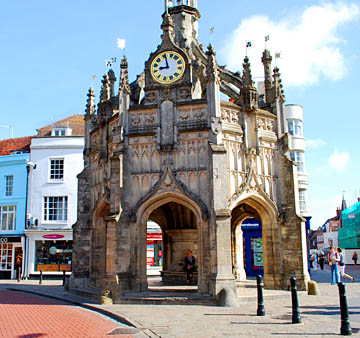
Chichester Market Cross.
Photo © S. Alsford
The Market Cross is an octagonal stone structure formed, essentially, from a cupola atop an outer wall strengthened by eight buttresses on the sides of archways, giving an arcaded appearance. The structure sits on a single-stepped paved base, which does not extend beyond the buttresses, with a second, lower step creating the interior floor. The thick, round central shaft, topped by ribbed vaulting extending to the outer pillars, is ringed by a stone lip at a height allowing it to serve as seating for market vendors who have their baskets, or other containers, of wares in front of or perhaps beside them. The Market Cross continued to serve this purpose until superseded by a market hall in 1807.
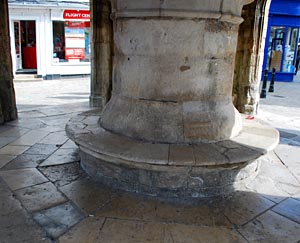
The stone seat at the centre of the Market Cross.
Photo © S. Alsford
The upper part of the central column, on which sits a lantern, is supported by flying buttresses. A large part of the structure's surface area is sculpted or moulded; sculptural motifs include: a bishop's mitre over the top of each entrance arch and episcopal arms, which would remind users of their benefactor and of episcopal authority in the city; figures of angels, as a reminder that commercial transactions all took place under divine oversight; and gargoyles and monsters, which would keep users conscious of the spiritual perils of false dealing. Other decorative, symbolic, or functional elements – such as statues and standards representing secular and ecclesiastical authorities, clock faces on three sides (each facing one of the four streets that converge at that spot and divide the city into four quarters), and weather-vane on top – are post-medieval additions.
d. Salisbury
Salisbury's hexagonal Poultry Cross is an older (fifteenth century) and less elaborate version of the Chichester structure and has a lighter feel. It comprises six archways (wider than those of the Chichester structure) whose piers support a parapeted roof, with a hexagonal central column surmounted by a cross-topped spire (feature of a nineteenth century restoration), which is supported by flying buttresses (feature of the same restoration, but replacing earlier versions). The whole structure sits on a paved base. The central column is, near the base, surrounded by a wide lip intended to serve as seating. Higher up the column, but below the roof, is a ring of sculpted angels. There are carvings on elements of the exterior, but they appear decorative rather than symbolic.
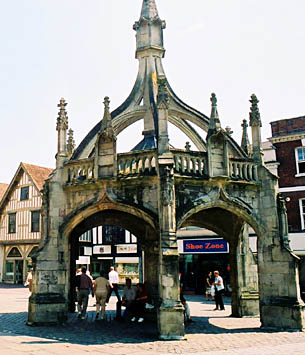
Salisbury Poultry Cross.
Photo © S. Alsford
Salisbury's marketplace was centrally located within the town, on the east side of St. Thomas's church. That church may have been built to service the market or may indicate one of the local foci of settlement in the area of New Salisbury prior to the removal of the cathedral and its clergy from the problematic site of Old Sarum. The consequent migration of many traders and artisans (perhaps particularly those in the building trades) from Old Sarum, in pursuit of their best customer, and the foundation of the borough of New Salisbury in the 1220s, following acquisition of licences for a market and a fair, stimulated the growth of the pre-existing settlement. This settlement was situated on the route (Minster Street) between the new cathedral and Old Sarum; the market also lay on an east-west route which ran from Winchester to the borough of Wilton, with which Salisbury would compete (successfully) for commercial dominance. It was a natural spot for a marketplace to develop. In this initial core of New Salisbury streets and burgage plots were laid out to attract new settlers, on much the same principles as at many other new town foundations, such as Winchelsea, though perhaps over a more extended period.
A cross is known to have existed on this site in Salisbury since at least 1307; it was first referred to as the High Cross and by the fifteenth century as the Poultry Cross. The present Poultry Cross is the only surviving of four such structures, being at the south-west corner of the marketplace, near the church. The Cheese Cross (built ca.1416) was situated in the north-west corner, known as Cheesemarket; vendors not only of cheese and milk but also of fruit were expected to operate only in that part of the marketplace, and that vicinity was also used by grain dealers. The Wool Cross was in the north-east sector of the marketplace where wool and yarn were sold; the Barnwell Cross was in an area where cattle were sold, outside the victuals marketplace. The earliest part of the marketplace was probably around the Poultry Cross; just south of it and the church were stalls/shops known as Old Poultry.
The layout of the marketplace provides a good illustration of how rows of stalls gradually became permanent fixtures, and by the sixteenth century had transformed into houses combining residences and shops. A rental of 1455 listed about a hundred shops, which is unlikely to represent a complete inventory, for a population of perhaps around 5,000. Just east of the Poultry Cross Butcher Row clearly indicates the nature of stalls once there and immediately south of it was a row later known as Coal Market, to the east of which was Fisher Row. Another evolved row, known as Oatmeal Row or Oat Market stretched between Poultry Cross and Cheese Cross and was also where vegetables were sold. The eastern end of the marketplace was where most non-victual wares were sold. Stocks, pillory, and probably the weigh-beam were placed along the north side of the marketplace, and slightly further north was Blue Boar Row, named for an inn known to be in existence by the fifteenth century. The base for civic administration was located initially between the Poultry Cross and St. Thomas' church, and later moved to the eastern side of the marketplace, facing Carter Street (which was in essence a second High Street), near to where the bishop had his own courthouse. In the area immediately surrounding the market were streets and lanes suggesting other clusters of commerce. We hear of Ironmonger Row, Cordwainer Row, Cooks' Row, Wyneman Street, and Mylkmonger Street, among others.
A structure with a similar appearance to those at Salisbury and Chichester was built at Norwich between 1501 and 1503, a civic initiative, to replace the market cross erected in 1411. Octagonal in shape and sitting atop a plinth 30 feet wide, it had a small chapel at its centre topped by a cross that was over 60 feet above ground level, surrounded by a covered arcade. Its site was recently rediscovered by archaeologists. The chapel consumed so much of the interior space it is hard to imagine the arcade could have served as a market house, although hucksters might have used the steps around the plinth; yet after the chapel was converted into a storeroom following the Reformation, stalls did indeed begin to appear there and the structure was later referred to as the Market House. The market house at Enfield, mentioned elsewhere is less ancient and less elaborate, but similar in essentials to those at Salisbury and Chichester.
e. London
In the fourteenth century victuals were being sold on the grounds of Leadenhall manor (whose manor-house was roofed in lead), at a market for its tenants; the manor was situated off Cornhill and, coincidentally, on one edge of the Roman forum-basilica which served as administrative centre and marketplace in the pre-medieval period. Edward III wishing to counteract a flourishing black market in victuals, especially poultry, required all vendors to sell in the same area of the city, this being the poultry market at Cheapside, but the large number of stalls overflowed into Leadenhall Street.
In 1377 the city authorities ordered that "foreigners who come to the City with cheese and butter for sale, in carts and upon horses, shall be charged to bring their wares into the market of the Ledenhalle, or the market between St. Nicholas Shambles and Neugate, and ... not put away in houses or in rooms, privily or openly" [H.T. Riley, Memorials of London and London Life, London, 1868, 405]. Particular concerns behind this ordinance were that suburban hucksters would visit rural markets north of the city to buy up dairy products, then sell them in the city streets, misrepresenting themselves as the producers, while other forestallers would intercept, in Holborn or Fleet Street, Welsh cheese en route to the city market and then retail it from private houses.
After the death of the manorial lord's widow, Richard Whittington negotiated to acquire the title to it, perhaps on behalf of Corporation (which had already been leasing it), handing over the site, as freehold, to the city three years later, in 1411. It was subsequently developed into a civic facility: in 1439 draper Simon Eyre – a man on the threshold of the upper ranks of civic officialdom – spearheaded a project to replace the manor-house with a public granary, schools, and chapel, the work being completed by 1453. Market stalls may have been located in the surrounding streets, but in 1455 the city council ordered vendors of poultry, dairy products, and other victuals to move into the granary. This was no mere wooden barn but a large and impressive market hall built by the city architect John Croxton in Italian style, with ground floor courtyard surrounded by an arcade to keep country vendors and their goods protected from rain, and an upper floor used for grain storage; the chapel and a well were provided for the convenience of vendors.
Leadenhall quickly became the principal London market for meat and poultry (it not being until much later that Smithfield took over the wholesale side of the business) as well as a public gathering place. Such facilities must have encouraged at least some rural producers to bring their foodstuffs into the city for sale, rather than selling through regrators, while assuring the city of stallage. Foodstuffs remained the core of this market's business. Although the site largely escaped damage in the Great Fire of 1666, the city authorities took advantage of the subsequent rebuilding programme to turn the poultry market itself into a covered structure, with sections for beef, greengrocery and herbs, and in the 1790s Eyre's hall was demolished.
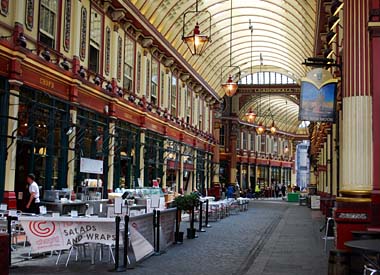
One part of Leadenhall market. The current indoor location, designed in
classical style and constructed of wrought iron and glass, dates from 1881,
following which shops were rented to butchers, fishmongers, and other victuallers.
Although today the businesses there are more diversified, a traditional butchers shop
can still be found (below). Butchers' shops are today much scarcer in England
and more sanitized than once they were.
Photos © S. Alsford
